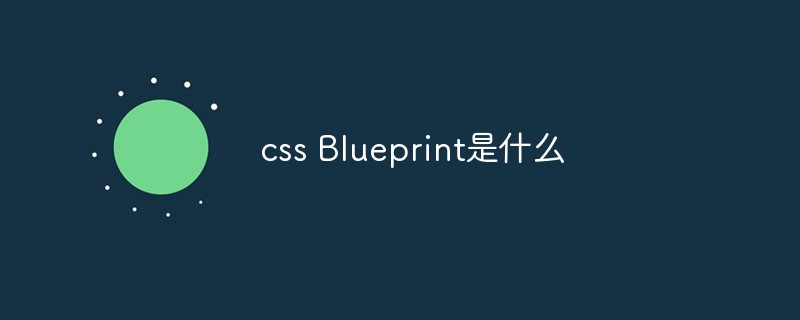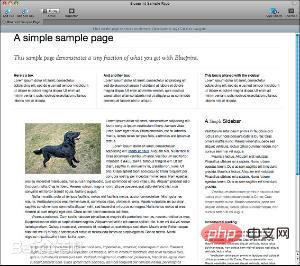What is css Blueprint
Blueprint is a CSS framework that divides layout, typography, widget, reset, and print into different CSS files.

The operating environment of this tutorial: Windows 7 system, Dell G3 computer.
Recommended: css video tutorial
Blueprint (CSS framework)
Blueprint is a CSS framework whose purpose is to reduce It’s time for your CSS development. It gives you a solid foundation in CSS, with an easy-to-use grid to base your top items on, sensible typography, and even print style sheets.
Use Blueprint as a guide when designing web pages, and then design or generate HTML so that Blueprint CSS styles are applied to HTML elements. In fact, because Blueprint provides powerful CSS, it is possible to design web pages in HTML without having to use a graphics design program, such as Photoshop, to simulate the final page. In a sense, Blueprint offers true What You See Is What You Get (WYSIWYG) web design because the prototype will use the same code as the final site.
In addition, because the main role of Blueprint is to simulate the appearance of a printed page, using Blueprint for interactive design feels more like using QuarkXPress or Adobe InDesign. Blueprint styles are based on pixels and a baseline grid of 18 pixels. With design talent and effort, it's possible to create professional-looking pages.
Style Example
Blueprint's default grid is 950 pixels wide, divided into 24 30 pixel wide columns separated by 10 pixel dividers: [( 24 columns * 30 pixels/column) (23 dividers * 10 pixels/divider) = 950 pixels]. If there is a preference or need for a wider or narrower grid or different column widths, Blueprint provides a Ruby tool for regenerating the Blueprint to the required specification. The Ruby tool also creates a grid image that can be referenced in Photoshop, and the final CSS is compressed to reduce file size, thus reducing transfer time and bandwidth.
Normally, Blueprint CSS files should not be edited. Instead, you should define your own styles in a separate file and override the Blueprint code as needed. This is the role of the last file, css/custom.css, which is created and maintained as part of the code.

For more programming-related knowledge, please visit: Programming Courses! !
The above is the detailed content of What is css Blueprint. For more information, please follow other related articles on the PHP Chinese website!

Hot AI Tools

Undresser.AI Undress
AI-powered app for creating realistic nude photos

AI Clothes Remover
Online AI tool for removing clothes from photos.

Undress AI Tool
Undress images for free

Clothoff.io
AI clothes remover

Video Face Swap
Swap faces in any video effortlessly with our completely free AI face swap tool!

Hot Article

Hot Tools

Notepad++7.3.1
Easy-to-use and free code editor

SublimeText3 Chinese version
Chinese version, very easy to use

Zend Studio 13.0.1
Powerful PHP integrated development environment

Dreamweaver CS6
Visual web development tools

SublimeText3 Mac version
God-level code editing software (SublimeText3)

Hot Topics
 How to use bootstrap in vue
Apr 07, 2025 pm 11:33 PM
How to use bootstrap in vue
Apr 07, 2025 pm 11:33 PM
Using Bootstrap in Vue.js is divided into five steps: Install Bootstrap. Import Bootstrap in main.js. Use the Bootstrap component directly in the template. Optional: Custom style. Optional: Use plug-ins.
 The Roles of HTML, CSS, and JavaScript: Core Responsibilities
Apr 08, 2025 pm 07:05 PM
The Roles of HTML, CSS, and JavaScript: Core Responsibilities
Apr 08, 2025 pm 07:05 PM
HTML defines the web structure, CSS is responsible for style and layout, and JavaScript gives dynamic interaction. The three perform their duties in web development and jointly build a colorful website.
 Understanding HTML, CSS, and JavaScript: A Beginner's Guide
Apr 12, 2025 am 12:02 AM
Understanding HTML, CSS, and JavaScript: A Beginner's Guide
Apr 12, 2025 am 12:02 AM
WebdevelopmentreliesonHTML,CSS,andJavaScript:1)HTMLstructurescontent,2)CSSstylesit,and3)JavaScriptaddsinteractivity,formingthebasisofmodernwebexperiences.
 How to write split lines on bootstrap
Apr 07, 2025 pm 03:12 PM
How to write split lines on bootstrap
Apr 07, 2025 pm 03:12 PM
There are two ways to create a Bootstrap split line: using the tag, which creates a horizontal split line. Use the CSS border property to create custom style split lines.
 How to set up the framework for bootstrap
Apr 07, 2025 pm 03:27 PM
How to set up the framework for bootstrap
Apr 07, 2025 pm 03:27 PM
To set up the Bootstrap framework, you need to follow these steps: 1. Reference the Bootstrap file via CDN; 2. Download and host the file on your own server; 3. Include the Bootstrap file in HTML; 4. Compile Sass/Less as needed; 5. Import a custom file (optional). Once setup is complete, you can use Bootstrap's grid systems, components, and styles to create responsive websites and applications.
 How to insert pictures on bootstrap
Apr 07, 2025 pm 03:30 PM
How to insert pictures on bootstrap
Apr 07, 2025 pm 03:30 PM
There are several ways to insert images in Bootstrap: insert images directly, using the HTML img tag. With the Bootstrap image component, you can provide responsive images and more styles. Set the image size, use the img-fluid class to make the image adaptable. Set the border, using the img-bordered class. Set the rounded corners and use the img-rounded class. Set the shadow, use the shadow class. Resize and position the image, using CSS style. Using the background image, use the background-image CSS property.
 How to use bootstrap button
Apr 07, 2025 pm 03:09 PM
How to use bootstrap button
Apr 07, 2025 pm 03:09 PM
How to use the Bootstrap button? Introduce Bootstrap CSS to create button elements and add Bootstrap button class to add button text
 How to resize bootstrap
Apr 07, 2025 pm 03:18 PM
How to resize bootstrap
Apr 07, 2025 pm 03:18 PM
To adjust the size of elements in Bootstrap, you can use the dimension class, which includes: adjusting width: .col-, .w-, .mw-adjust height: .h-, .min-h-, .max-h-






